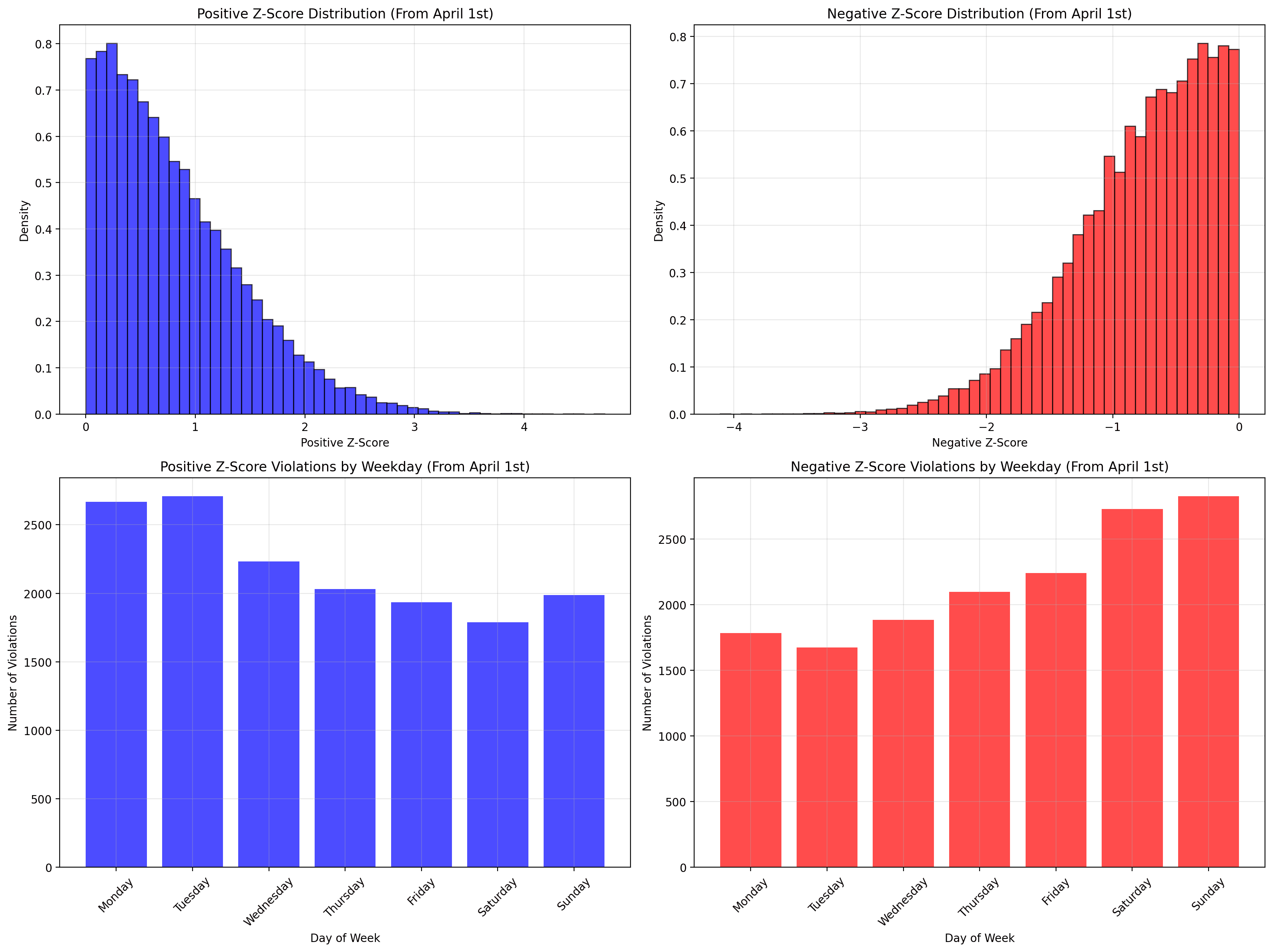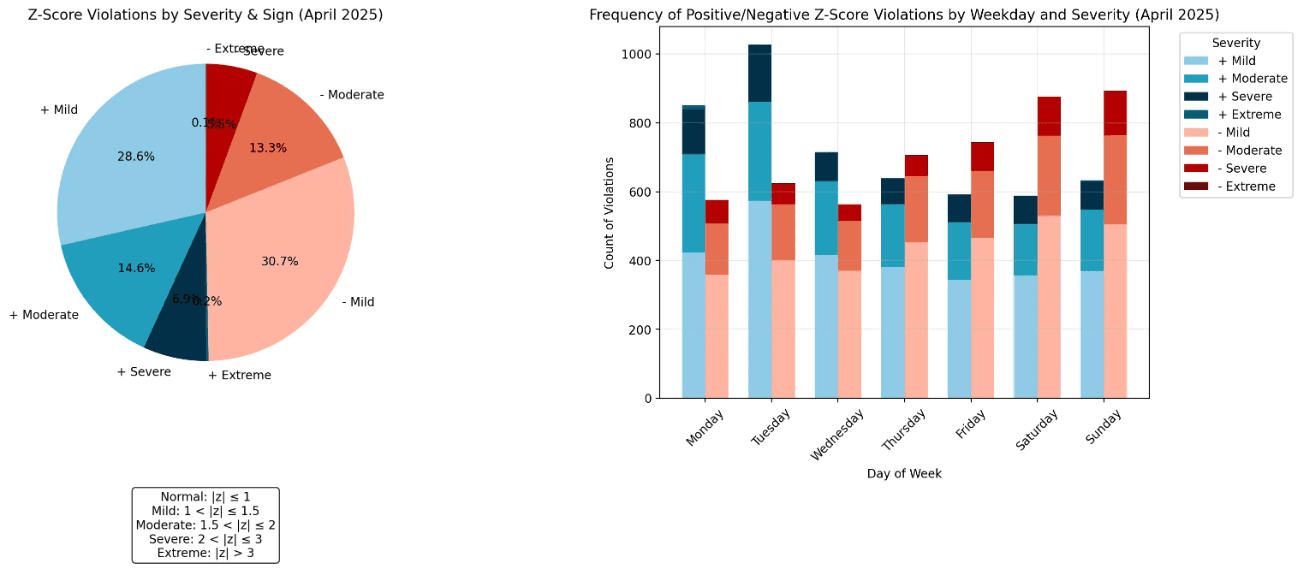- HRV rebounds early in the week (A validation of last week’s finding!) The strongest positive swings in HRV occur on Monday and Tuesday, suggesting that the nervous system tends to recover. Possibly a delayed recovery after weekend rest. Maybe we should all do our hardest training on a Tuesday?
- Negative swings cluster at weekends. Drops in HRV are most frequent on Saturdays and Sundays, likely reflecting cumulative fatigue, social strain, alcohol, or later nights.
- Big HRV changes are rare but meaningful. Only about 4% of daily HRV shifts exceed ±2 standard deviations, but these moments signal significant physiological stress or recovery. Tracking these outliers helps identify when the body is truly under strain or bouncing back.
Oura Ring Series
Descriptive HRV using Z scores
September 19, 2025
Stay updated with our latest research
Get the latest reports and insights from Terra Research delivered to your inbox.
Descriptive HRV using Z scores
In the last blog, we looked at the general patterns of HRV and Sleep data for a population of Oura users. We described the population's absolute and delta HRV, as well as sleep data, using the means, which revealed the general pattern. This week, we go a little deeper. Firstly, by standardising the data using Z-scores and secondly, by looking at individual variable links.
The analysis involved nearly 100,000 HRV records from April to June 2025, collected from 1,199 users of wearable devices. Our goal? Understand the magnitude and direction of daily HRV changes and determine if these changes follow meaningful patterns across days of the week.
We used the Oura HRV metric, which is calculated using several appropriate overnight sample periods using the RMSSD method.
Why Focus on Delta HRV?
While raw HRV can be a helpful snapshot of autonomic recovery, how HRV changes from one day to another is more meaningful. A large drop in HRV might signal poor sleep, late-stage fatigue, or elevated sympathetic stress (or all of the above!) A rebound might reflect recovery, adequate rest, or reduced strain. But — critically — a 10 ms drop means very different things for different people. That’s where z-scores come in. It allows us to “smooth” the data and compare the magnitude of HRV changes.
A z-score lets us measure how far a daily HRV change deviates from a person’s typical variability. Instead of using a fixed threshold, such as “±10 ms”, we use the individual’s mean and standard deviation to define significance. A z-score of +2 is probably a strong signal of recovery. “This HRV increase was two standard deviations larger than usual.” A z-score of minus 2 means “this was an unusually large drop in HRV” — potentially a flag for stress or strain.
Using z-scores allows us to: compare different users on a fair playing field, quantify physiological surprises and track extreme events, not just typical trends. I can hear the statisticians shouting at me at this point, but are delta HRV Z-Scores normally distributed!? The answer is not quite. But we are not using Z-scores here to make strict inferences, just as a way to standardise different days’ scores for comparison.
Defining HRV Violation Severity
Here’s how we bucket HRV delta z-scores based on their severity:
| Severity | Z-Score Range | Positive frequency % | Negative frequency % |
|---|---|---|---|
| Normal | -1 ≤ z ≤ +1 | 66.25 | 67.7 |
| Mild Violation | 1 < | 19.15 | 19.98 |
| Moderate Violation | 1.5 < | 9.79 | 8.66 |
| Severe Violation | 2 < | 4.64 | 3.58 |
| Extreme Violation | 3 < | 0.16 | 0.07 |
Key Findings
From April 1st to June 24th, 2025, we analysed, 95,623 daily HRV deltas, across 1,199 users.
Z-score overview:
There were 46,365 (48.5%) positive Z-scores, 49,150 (51.4%) negative Z-scores. With 30,584 (32%) violations over Z=1 and 4,210 (4.4%) violations over Z=2. The mean positive Z-score was +0.825, and the mean negative Z-score was -0.778.
Breakdown by Severity

Most HRV swings fall into the mild or moderate category, but severe or extreme drops still occurred in more than 1 in 100 cases — suggesting meaningful day-to-day stressors are not rare, and the possibility of noise based outliers.
Weekly Patterns: When Swings Happen
You can see from figure 1 that large positive HRV changes tend to happen early in the week with negative changes happening more frequently over the weekend.
The implications here are striking and back up the trends we identify in our last blog. HRV tends to rebound early in the week, following weekend rest — but dips sharply again by Sunday, likely reflecting the cumulative load of the workweek or weekend activity.

What Does This Tell Us?
This data suggests a few takeaways for users, coaches, and anyone interested in nervous system recovery:
Your HRV is most likely to rebound on Monday or Tuesday — as we summerised last week, don’t skip the start of the week.
Negative swings are most common on weekends — we are guessing here, but possibly due to overreaching, alcohol, social strain, or late nights!
Big changes are relatively rare — but they matter. The 4% of changes greater than z=2 represent moments of physiological significance.
Delta HRV moves in similar positive and negative jumps. This surprised us. Our personal experience is that the negative jumps tend to be larger than the positives.
Final Thought
Recovery is very dynamic, not static, and often HRV is looked at solely in terms of multi-day trends. We wanted to investigate delta HRV and Z-scores to see if any insights emerged from trying to look at a more dynamic HRV based metric.
In reality this tell us what we already know; our HRV is in constant flux, mostly involving small changes and less frequently involving large changes. The one surprise, for us, that did emerge was that the positive swings are slightly larger, but more concentrated in terms of the days they occur on. The trend is for people to show relatively larger recovery over Sunday and Monday nights followed by a downward trend of relatively smaller negative swings during the week.
If your HRV takes a dive on Sunday — maybe skip the extra set on Monday. If it spikes on Tuesday? Lets go for it!




